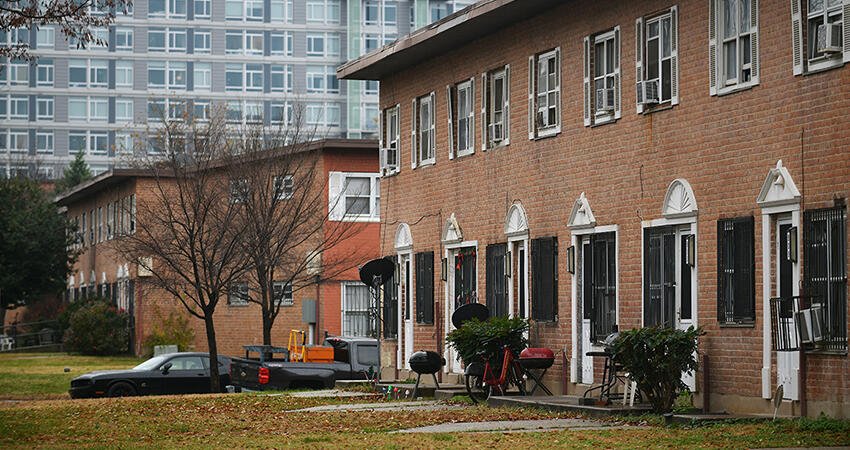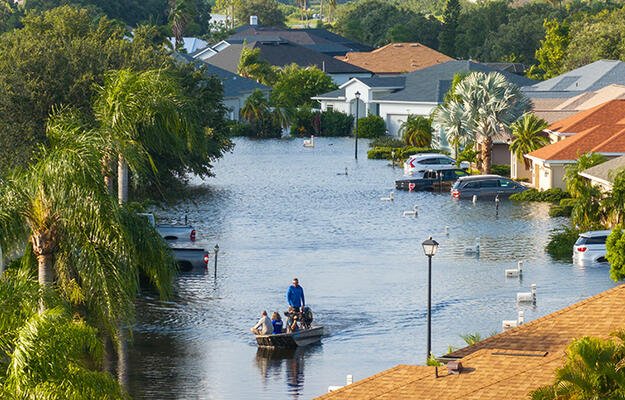
The Washington Post/Getty Images
Addressing Climate Change through Housing Policy: Lessons from the Greater DC Region
This post was originally published on Urban Wire, the blog of the Urban Institute.
Intensifying climate change requires greater efforts by policymakers, developers, and homeowners to retrofit and adapt housing. Currently, residential energy use accounts for approximately 20 percent of greenhouse gas emissions nationally, and building energy consumption accounts for 74 percent of all emissions in the District of Columbia (PDF).
Wealthy DC-area suburbs in Montgomery, Fairfax, and Loudoun Counties emit substantially more greenhouse gases per household than other areas in the DC region. Yet, neighborhoods of people with lower incomes disproportionately face more risks from climate change. Most federal funding is directed to homeowners with higher incomes when disasters occur, often excluding homeowners with lower incomes and renters.
Systemic historic and persistent racist policies have also pushed Black and Latinx households into areas more prone to flooding (PDF), with higher levels of pollutants, and with worse housing conditions, making these households more susceptible to climate change effects. Black and Latinx households and households with lower incomes are also more likely to be energy insecure and unable to afford proper heating and cooling for their homes.
As climate change continues to cause detrimental effects, climate mitigation and adaptation programs need to better address the needs of renters, Black and Latinx residents, and people with low incomes. For this year’s Housing Indicator Tool—a platform that tracks local jurisdictions’ housing production and preservation in the greater DC and Baltimore regions—we collaborated with the Housing Association of Nonprofit Developers to include questions about local policies that target climate change mitigation and adaptation in the housing sector. Here, we lift up promising strategies from the DC region that can address the needs of the communities most susceptible to climate risks.
Improving the climate resilience of new and current housing
Federal funding to support climate change adaptation resources for residents and local jurisdictions is higher than ever before, including programs such as the $3 billion allocated to the US Department of Energy’s Weatherization Assistance Program. Local governments should be prepared to distribute these funds and provide supplemental programs to advance climate goals and housing resilience.
Local governments have discretion to require or incentivize developers to build and renovate housing that’s more energy efficient, for example, by updating their building codes with higher standards. In the DC and Baltimore regions, all but a few small jurisdictions require a minimum energy-efficient standard for new buildings. As climate change worsens, cities are implementing stricter energy-efficiency standards and moving toward net-zero building codes. In DC, the Clean Energy DC Building Code Amendment Act of 2022 requires adopting a net-zero energy standard by 2026 for new buildings and substantial renovation on all commercial and residential buildings taller than three stories.
Along with housing adaptation, local stakeholders could encourage denser housing. Arlington’s Green Building Density Incentive Program offers developers additional density in exchange for LEED Gold (v4 or v4.1) certification, additional energy requirements, and other environmental components. Jurisdictions could further consider removing clauses where energy standards are only required for larger buildings, such as DC’s requirement only including residential buildings higher than three stories. To address the potential increased cost of housing development, new buildings with substantial affordable units could receive tax incentives or subsidies to meet energy standards.
Retrofitting existing housing is also essential for reducing residential buildings’ emissions. Local programs and resources to reduce the costs of retrofitting for homeowners with low and middle incomes could increase energy efficiency and decrease utility costs. Renters could benefit as well if local jurisdictions include affordable housing providers in programs.
DC has a multitude of rebate and retrofit programs for every resident through DC Sustainable Energy Utility, and Solar for All provides free solar panel installation for residents under a certain income level, including tenants in one- to four-unit homes. DC residents with low incomes in multifamily buildings can save on utilities through credits from community renewable energy facilities. Owners and managers of affordable multifamily buildings in DC can access the Efficiency Fund to support renovations to improve energy efficiency.
Other localities, such as Arlington and Fairfax counties, fund nonprofits to provide retrofitting services, like the organization Rebuilding Together. Although retrofits could result in higher rents after renovation, permanent affordability requirements could help residents with low incomes access affordable, efficient housing.
Informing tenants about climate change risks
Targeted outreach and education surrounding climate disasters, hazard disclosures, and available resources are necessary for residents to benefit from climate mitigation policies and programs. In general, tenants often receive no information on climate hazards when signing a lease, so local jurisdictions could implement hazard disclosure laws for both renters and homeowners. Prince George’s County is the only jurisdiction out of the 20 in the Housing Indicator Tool that requires multifamily rentals in flood plains to inform the tenant in the lease. Other cities and counties could add similar tenant protection laws.
The National Flood Insurance Program provides homeowners and renters with protection, but local jurisdictions could help residents understand its importance, especially those in areas with high flood risk, such as communities around the Anacostia River. Many homeowners in floodplains are required by lenders to have flood insurance. Yet coverage is limited, and floods in DC frequently happen in neighborhoods not marked as floodplains. In addition, most rental insurance doesn’t cover flood damage.
To promote their flood awareness campaign, DC policymakers have put advertisements across the city and in busy metro stops, providing a QR code to their flood insurance website and highlighting renters’ flood insurance options. DC’s Department of Energy and Environment also partnered with community-based organizations for a monthly series sharing DC’s strategies to protect buildings and ways residents can protect their homes in the high-risk flood zone in Northeast DC around the Watts Branch Tributary. Flood Resilient Arlington expanded their outreach to high-risk homes for flood-proofing site visits, held forums on flood insurance and flood-proof design, and created a StoryMap to educate residents on historical and present-day flood challenges. Local jurisdictions targeting outreach and education programs are vital for protecting residents from increasing flood risks, and these lessons can be extended to other climate hazards.
Ultimately, climate change crises disproportionally affect renters, residents with low incomes, and Black and Latinx households, even though less dense neighborhoods and wealthier households contribute higher levels of greenhouse gas emissions on average. To protect the residents most vulnerable to climate change, local policymakers should consider ways to require and incentivize housing resilience and climate adaption.


